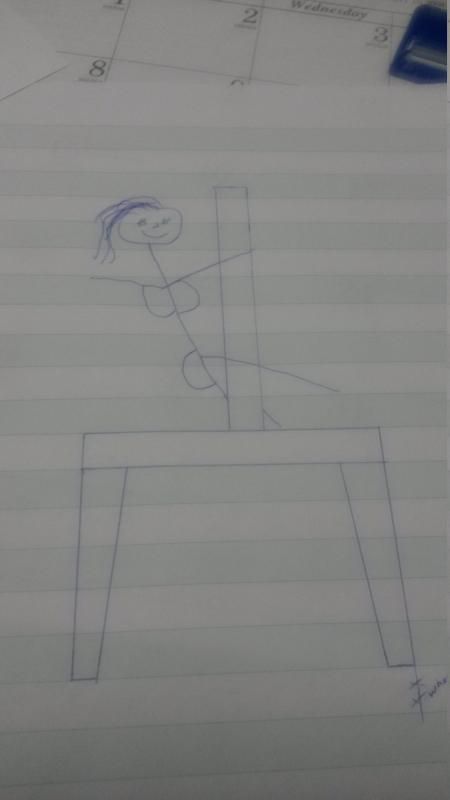Originally posted by BradM
View Post
Announcement
Collapse
No announcement yet.
Table held up by buckets resting on it.
Collapse
X
-
Boundary condition for pi/2 is not valid since table would have to rise to height of pulley.
So any mass of table less than 6 buckets, the buckets would rest on the table.Last edited by TexasDevilDog; 12-12-2014, 10:42 PM.class joke
{
private:
char Forrest, Jenny, Momma, LtDan;
double Peas, Carrots;
string MommaAlwaysSaid(const bool AddAnyTime = True)
};
Comment
-
you seriously are putting that much effort into this?Originally posted by TexasDevilDog View PostBoundary condition for pi/2 is not valid since table would have to rise to height of pulley.
So any mass of table less than 6 buckets, the buckets would rest on the table.
the buckets together weigh more than the table. This is a piece of artwork, and I seriously doubt that they are sitting there without being attached to the table. If it wasnt nailed down, someone *could* bump it and there would be a mess.
In conclusion: all of this is bullshit, and texasdevildumbasss is still an idiot."If I asked people what they wanted, they would have said faster horses." - Henry Ford
Comment
-
Geez! Don't get a wad in your panties. The BS flag was for myself, not you, because even after 2 months, I still wouldn't be able to come up with an equation.Originally posted by YALE View PostFirst I gave you the explanation you wanted in plain English, then you moved the goal post and asked for the, "equation," that explains it, and I'm bullshitting? Get the net, stumpfuck.
I didn't move the goalpost. My original question specifically asked for an equation. Actually, it was the 2nd post I made in the last thread, but I deleted it because I discovered that my first question had been copied to this one, so I moved the question over here. Why so sensitive? It's just a simple question.
Comment
-
Originally posted by TexasDevilDog View PostAgreed, and then solve for the boundary condition for when the table goes down, means the angle of the pulley approaches zero.
The equation I got was Mb = mass of bucket , Mt = mass of table, Θ = angle of pulley.
2Mb(1 + cos(Θ)) = Mt
The mass of the table can't be any higher than six times the mass of the bucket for an angle approaching zero.
Thank you!!! This was what I was after. 10 points for you!!!
Comment
-
Apologies. That was less than clear.Originally posted by line-em-up View PostGeez! Don't get a wad in your panties. The BS flag was for myself, not you, because even after 2 months, I still wouldn't be able to come up with an equation.
I didn't move the goalpost. My original question specifically asked for an equation. Actually, it was the 2nd post I made in the last thread, but I deleted it because I discovered that my first question had been copied to this one, so I moved the question over here. Why so sensitive? It's just a simple question.ZOMBIE REAGAN FOR PRESIDENT 2016!!! heh
Comment
-
Don't be such an engineer - throw some common sense in there. Everything in that picture is relative.Originally posted by TexasDevilDog View PostThe mass of the table can't be any higher than six times the mass of the bucket for an angle approaching zero.
If the table goes down the buckets go up. Why can't the table be any more than 6 buckets worth of weight? All it takes (generally) is the table weighing more than the approximately the sum of the bucket weight (angles, sin theta, blah blah). T>~4B = movement. The table could be 20 times the bucket weight and it would still go down and raise the buckets until the table hits the ground or the buckets hit the pulleys.
Comment
-
I meant to say thank you to you also. That is mostly way above my head, but I find it interesting, nonetheless.Originally posted by TexasDevilDog View PostAgreed, and then solve for the boundary condition for when the table goes down, means the angle of the pulley approaches zero.
The equation I got was Mb = mass of bucket , Mt = mass of table, Θ = angle of pulley.
2Mb(1 + cos(Θ)) = Mt
The mass of the table can't be any higher than six times the mass of the bucket for an angle approaching zero.
Comment
-
see post #33.Originally posted by Strychnine View PostDon't be such an engineer - throw some common sense in there.
If the table goes down the buckets go up. Why can't the table be any more than 6 buckets worth of weight? All it takes (generally) is the table weighing more than the approximately the sum of the bucket weight (angles, sin theta, blah blah). T>~4B = movement. The table could be 20 times the bucket weight and it would still go down and raise the buckets until the table hits the ground or the buckets hit the pulleys.
How do you look at that and think that the table weight is the limiting factor to anything?"If I asked people what they wanted, they would have said faster horses." - Henry Ford
Comment
-
Sorry that most of you can't understand that there is only one equation that describes this problem with three unknown variables; bucket mass, table mass, angle of the rope. That leads to answers found with boundary conditions.
I am sure that everyone on here smarter than me will be posting their picture of their math proof contradicting my math proof.class joke
{
private:
char Forrest, Jenny, Momma, LtDan;
double Peas, Carrots;
string MommaAlwaysSaid(const bool AddAnyTime = True)
};
Comment
 [/URL]
[/URL]
Comment